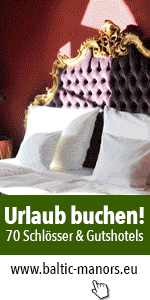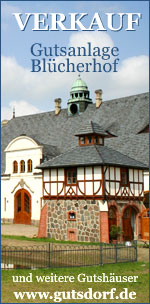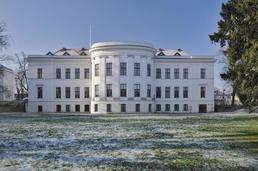Deutsche Website
Book "Manor houses and castles in Mecklenburg"

In Volume 3, we present 43 estates on 156 pages with short texts and more than 220 historical and current photographs.
Bad Doberan
In 1171, Bishop Berno of Schwerin and the Obotrite prince Pribislav founded a Cistercian monastery on the site of what had been the Germanic settlement of Althof.
In 1294, the building of a High Gothic cathedral began. One of the most important Brick Gothic buildings in the whole of the Baltic region, Doberan Minster's beautiful interior harbours numerous pieces of great artistic value. Doberan, the small settlement just outside the cathedral precinct, rose to significance at the end of the 18th century as the favourite getaway and summer residence of Duke Friedrich Franz 1 of Mecklenburg. Following the establishment of a spa resort at Heiligendamm, the architect Carl Theodor Severin was commissioned to develop the centre of Bad Doberan, which was built around a park known as the "Kamp". In 1801, work began on the Grand Ducal Salon (Großherzogliches Salongebäude), and between 1806 and 1809, the Grand Ducal Palace (Großherzogliches Palais) was built. The Guest House (Logierhaus) built in 1796 by J. C. H. von Seydewitz was also extended to deal with the growing streams of visitors to the town. The Small Palace (Kleines Palais), a handsome Neoclassical stucco building, was built between 1810 and 1813 for Severin to live in, but served from 1822 onwards as a royal summer residence ("princes' palace"). In the park itself, two pavilions were built - the Red Pavilion was started in 1808 and completed in 1809, and the White Pavilion was erected between 1810 and 1813.
For further information: www.bad-doberan.de
Großherzogliches Palais
The Grand Ducal Palace is a Neoclassical building designed by Carl Theodor Severin and built between 1806 and 1809. Today it houses district council offices. The "Oval Room" boasts panels of a famous French wallpaper depicting the story of Cupid and Psyche.
Großherzogliches Salongebäude
The Grand Ducal Salon was also designed by Carl Theodor Severin and built in 1801/02. In 1819 -21, a spacious room with a portico leading onto the garden was added. This room is particularly suitable as a venue for classical concerts. The Salon now houses administrative offices for the district of Bad Doberan.
Logierhaus
The Guest House, which was built in 1796 by J. C. H. von Seydewitz, is today a hotel, so once again serves its original purpose. It was extended at the beginning of the 19th century by Carl Theodor Severin.
Kleines Palais
This handsome Neoclassical stucco building was built by C. T. Severin between 1810 and 1813 for his own use as a house. From 1822 onwards it served as a royal summer residence ("princes' palace").
Pavillons auf dem Kamp
The "Red Pavilion", an octagonal timber frame building designed by C. T. Severin, was built in 1808/09 as a sales pavilion. It now houses a gallery and exhibition space. The "White Pavilion", also designed by C. T. Severin, was built between 1810 and 1813 as a concert hall. It now serves as a café.
Information and accommodation service
18209 Bad Doberan,
Phone:
038203-62154
Fax:
038203-77050
Email:
infoSPAMFILTER@bad-doberan.de
Url: www.bad-doberan.de




